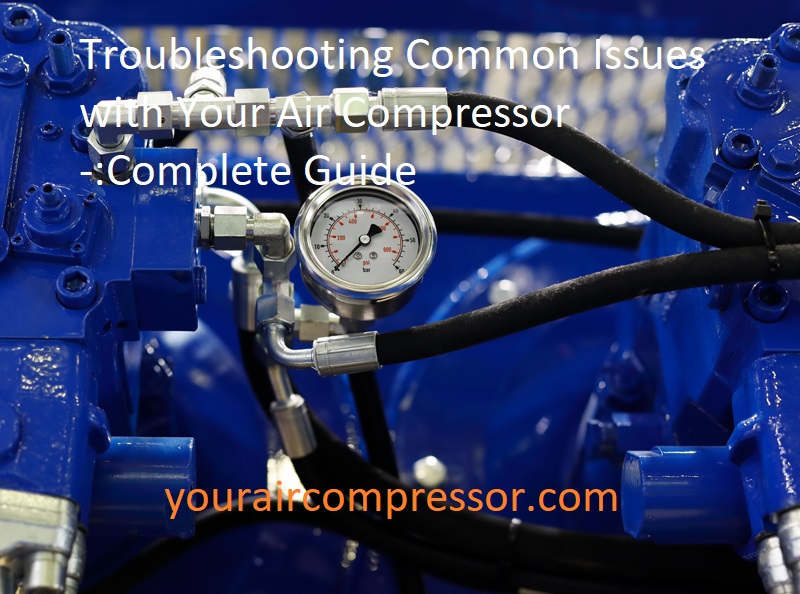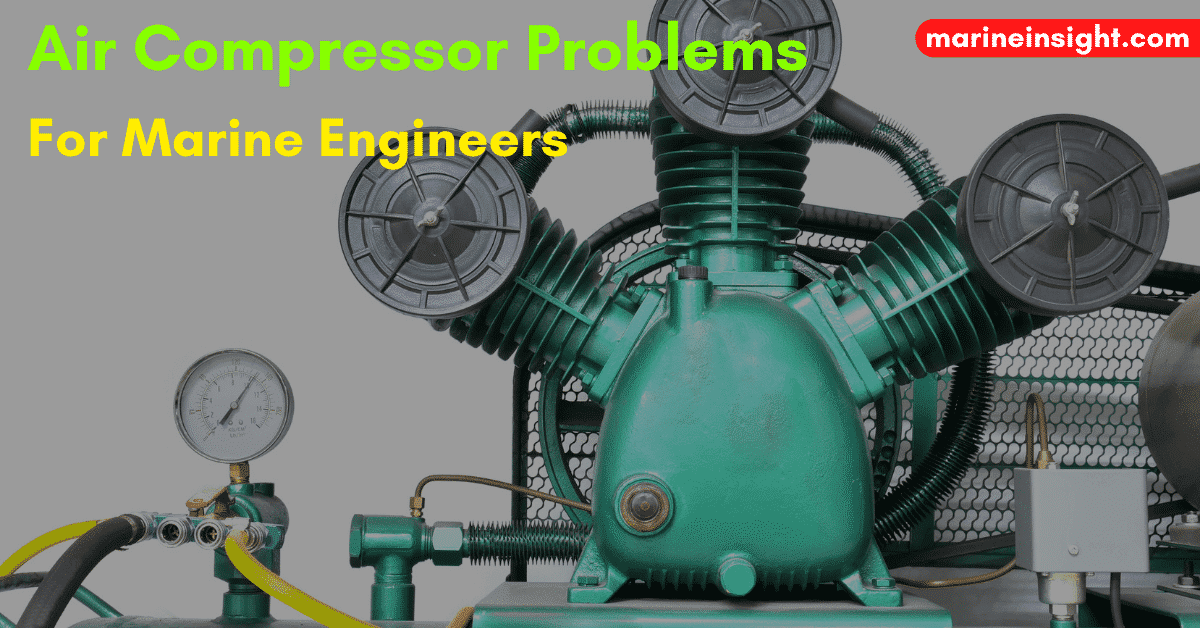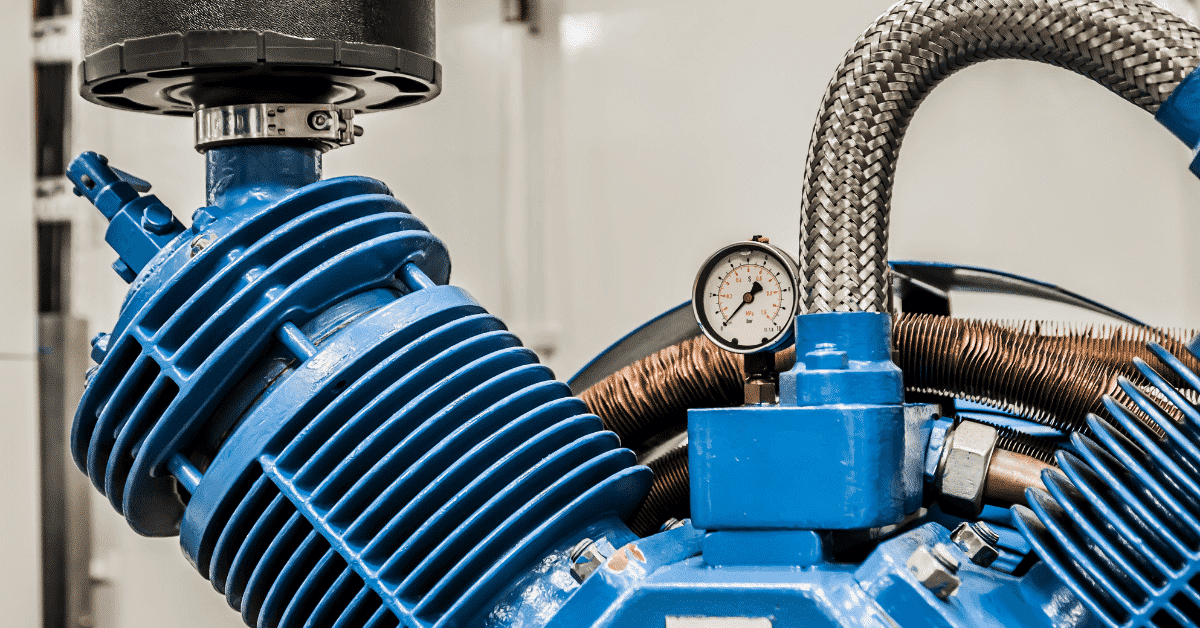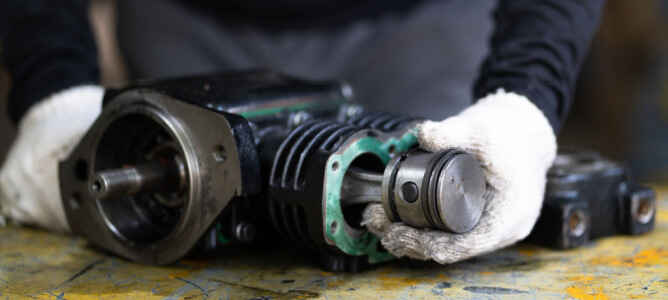 Are your air compressor issues causing you an array of problems? Look no further! Here we provide an easy troubleshooting guide to help you quickly identify and fix common air compressor issues.
Are your air compressor issues causing you an array of problems? Look no further! Here we provide an easy troubleshooting guide to help you quickly identify and fix common air compressor issues.
You can put away your repair tools and get back to your projects with ease!
This guide is designed to help you troubleshoot common issues with your air compressor. In this post, we will cover the basics of air compressor maintenance and discuss common air compressor problems and their solutions, from general maintenance to specific steps for repair. We’ll also discuss the different types of air compressors, how they work, and what to look out for when buying a new one. We hope that by the end of this guide you will have gained some insight into how to diagnose and solve problems with your air compressor.
Before you begin troubleshooting any type of problem or issue with your equipment, it’s essential that you understand some of the basics about how an air compressor works. An air compressor is a mechanical device used to convert energy into potential energy stored in pressurized gas. The environment around an air compressor can be volatile and hazardous when not handled properly so it’s important that you follow all safety guidelines outlined by the manufacturer before working on your unit.
Additionally, make sure to read through all service records that accompany your product so that you have an understanding of the past performance history before making repairs. This will give you insight into areas which may be more prone to repair than others, as well as a good idea if there are any potential underlying issues which need further investigation beyond just basic maintenance tasks.
Explanation of what an air compressor is
An air compressor is a device that pressurizes air, which can then be used to power other tools or provide additional pressure to certain areas. This type of compressor typically consists of an electric motor, valve, piston, and tank. Air is drawn into the unit’s pumping chamber and compressed in the chamber by the increasing pressure created by the motor’s rotation. As this pressure rises, it is routed to a storage tank for later use.
A key feature of most air compressors is the ability to adjust output pressure levels for different uses. This means that compression levels can be adjusted even when no additional power source is available. It also provides flexibility in how different products are used with an air compressor. Additionally, compressors can be used to inflate tires, fill gas tanks in automobiles, and deliver high-pressure streams of water or other liquids needed to operate industrial tools as well as machinery and engines.
Importance of proper maintenance and troubleshooting
Proper maintenance of the air compressor is essential to ensure that you get peak performance as well as a long life out of your machine. When it’s not maintained and serviced regularly, it can suffer from common issues such as starting and stopping problems, low airflow, compressor overworking, excessive temperatures, unexpected noises, leaks in the system and other problems.
To prevent these issues from arising, be sure to follow regular maintenance schedules recommended by the manufacturer for the specific model of air compressor you use. This includes lubricating any moving parts when necessary, checking for oil and air filter levels, inspecting for loose connections or valves that need to be repaired or replaced. Take note of any unusual sounds when starting or running the compressor so that you can perform additional troubleshooting if needed.
Troubleshooting issues with your air compressor can be done in several ways such as inspecting all connections for dryness or wear and tear, ensuring all valves are open correctly; re-setting all electrical switches; replacing worn hoses or gaskets; increasing pressurization if required; checking pressure gauges to ensure they are kept within normal levels throughout use. Moreover, it is advisable to draw out a detailed operational manual outlining steps taken during operating your air compressor in order to better identify exactly what needs repairing when an issue arises.
Purpose of the guide
This guide is designed to provide an in-depth explanation of your air compressor and the various components that are used to create a working system—along with tips on troubleshooting your equipment should any issues arise. An air compressor has many moving parts that can cause breakdowns or other problems if they’re not functioning correctly.
By understanding the purpose of each component, you’ll be better equipped to identify and fix any issues quickly and on your own. In this guide, you will learn the purpose of an air compressor, how it works, what types of compressors are available and common problems associated with them. You will also learn how to properly maintain your machine and extend its life by addressing common problems before they cause significant damage or lead to expensive repairs.
Common issues with air compressors
When it comes to common issues with air compressors, the most common ones are related to performance and maintenance. In this section, we’ll discuss a few of the common issues you may encounter and explain how to troubleshoot them.
- Low air pressure: Low air pressure can be caused by several factors, from dirty filter elements to leaking components or worn seals. Always check your filter elements first as this can be an easy fix that you can do quickly and safely. If the filter isn’t the issue, then take apart the unit and inspect for any worn or leaking components or seals. Make sure to replace any damaged parts promptly before running the compressor again.
- High air pressure: High air pressure is often caused by a defective pressure regulator or unbalanced mixing valve settings. Check both of these settings first and adjust accordingly if they are out of balance (remembering to always wear protective gear when performing maintenance). If these settings are fine, then check for any faulty hoses, clogs in the line or leaks in other areas as these can cause airflow restriction which will result in higher than normal air pressures in your system.
- Noisy compressor: Excessive noise from an air compressor can indicate that either some part is coming lose inside (such as a bearing), or someone may have overfilled your unit with oil causing it not to run properly and make more noise than usual. Inspect for loose parts before filling up on oil – too much oil will reduce performance which could lead to further problems down the road – and never forget about checking for leaks! Leaks will also cause excessive noise as well as reduced performance and should be addressed immediately upon detection before returning the unit back into service again.
Overview of common problems
It is important to be aware of the common issues that might arise with your air compressor so that you can quickly diagnose and fix any problems before extensive damage is caused. Air compressors can experience a variety of issues, from mechanical damage to malfunctioning start buttons. Before attempting any repairs, it is important to properly identify which issue you are dealing with in order to ensure that appropriate measures are taken.
This guide will provide an in-depth overview of the most common air compressor issues and will provide valuable tips for troubleshooting and repairing them. We will start by discussing general causes for common problems such as inadequate pressure levels and noisy operating, then move onto more specific topics such as bearing failures, electrical malfunctions, and corrosion or unstable Motor malfunctions. We will also cover how to maintain your air compressor in order to reduce or prevent future breakdowns. With this knowledge you should be able to fix most issues yourself without needing professional help.
Symptoms of a malfunctioning air compressor
If your air compressor is not working properly, it could indicate a major issue. If you’ve noticed any of the following symptoms with your compressor, it’s a good idea to inspect and repair the affected components as soon as possible:
-Reduced air pressure – If you find that the air pressure coming out of your air compressor is too low or not consistent, you likely have a faulty component such as an unclogged filter, malfunctioning valves, or an improperly calibrated flow control valve.
-Vibrations – Vibrations can be caused by something as simple as an unbalanced load or as complicated as a misalignment of internal components. Identifying the source of vibrations must be done carefully, and any misaligned parts should be realigned to end excessive vibration.
-Unusual noises – Abnormal noises are usually caused by a bearing problem in the motor or other moving parts inside the compressor unit. Bearing issues should addressed promptly in order to prevent further damage to the unit.
-Frequent breaker trips – If you find that frequently turning off and/or resetting circuit breakers is necessary when using an air compressor, it’s likely that there’s been an overload on one of the wiring harnesses inside your unit. Check these components for burnt wires or shorts in order to restore power correctly.
Troubleshooting tips
When it comes to troubleshooting an air compressor, the first thing to consider is whether the compressor is a gasoline-powered or electric model. While they both share common problems and solutions, there are some differences in how to diagnose and fix each type.
Gasoline-powered Air Compressors: These types of compressors often use motors that are designed for short runs only, so if you find that your compressor does not start up after a few attempts, this could be an indication of a low battery or problem with the starter/ignition system. Additionally, check that oil levels are at adequate levels as insufficient lubrication can also cause your compressor to malfunction.
Electric Air Compressors: Common issues with these compressors may include an overly noisy motor or pump, fluctuations in pressure, and improper operation due to incorrect voltage. Check to ensure all connections are completely plugged in and tightened properly before examining any other parts of the machine. Oil should also be checked for optimum operation, as well as breakers/tester connections for proper operation. In some cases a defective safety valve can prevent air from escaping from the tank causing low pressure in the outlet hose when full pressure is indicated at regulator knobs and gauges. In this case, check for corrosion or sticking and replace with new valve if necessary.
Safety precautions before troubleshooting
When troubleshooting an air compressor system, it is important to keep safety in mind at all times. Air compressors can be dangerous due to the possibility of explosion if not handled properly, therefore it is essential that you take the time to understand and follow safety guidelines.
Before beginning any tasks on an air compressor system, make sure to disconnect it from any power sources and depressurize it. Additionally, be sure to wear the appropriate protective clothing, such as goggles and gloves, when working on the unit.
Another important aspect of safety is checking for leaks; if a leak is detected, do not attempt to repair the part yourself—contact a trained technician for assistance in this matter.
Once all safety precautions have been taken are you are comfortable with your proficiency in handling air compression equipment, then you are ready to start assessing and troubleshooting any issues with your unit.
Steps to follow when troubleshooting
Troubleshooting your air compressor might sound intimidating, but it doesn’t have to be. Although the types of issues you might encounter vary depending on the model or brand of your machine, there are some general steps you can take to troubleshoot basic problems. Listed below are some key steps to follow when diagnosing a malfunctioning air compressor.

- Check the oil level in your compressor’s tank by removing the drain plug and looking inside. If the oil is not up to the manufacturer’s recommended level, add more until it is filled.
- Check for any leaks in hoses or seals using soapy water and a flashlightor a leak detector tool for smaller spaces between connections. Make sure all connections are properly tightened and sealed with Teflon tape if needed.
- Inspect belts and pulleys for signs that they may need replacing due to wear or stretching of rubber material on them from regular use. Replace any worn-out parts if necessary. Fix any loose connections at this stage as well as inspecting for clogs in intake screens or filters which could result in lack of airflow or low pressure output from your machine too low measurements on gauges may indicate clogs present near blower section of device or in exhaust lines attached to tank intake/outlet valves; check with shop manual instructions given device make/model series numbers listed in instructions booklet included with product delivery kit items given part ordering instructions during shopper registration prior received standard shipment notification support services (if applicable).
Techniques for diagnosing specific issues
If you’ve exhausted the suggestions above and still have trouble with your air compressor, it may be time to move on to diagnosing specific issues. Certain problems like a faulty pressure switch or a bad control valve will require expert assistance, but some basic troubleshooting can often pinpoint the source of your obstruction or lack of pressure. Here are some tips for tackling specific issues with your air compressor:
Air Leakage – Tighten all connections and check for signs of damage along hoses before replacing o-rings or other seals. If an air leak persists, inspect the rings around knobs and buttons on the machine’s housing and replace any that appear worn.
Insufficient Pressure – This common problem can indicate an air leak in your system, which will require tracing back from the compressor to determine where it is originating from. If there are no obvious leaks, inspect all the valves on the machine for malfunctions and ensure that filters are not clogged. It is also possible that inadequate airflow could be attributed to a malfunctioning pump or motor.
High Pressure – This issue could be caused by overfilling tanks or obstructed unloading valves that are unable to properly relief pressure when necessary. If these fail-safes are not available as safety features with your machine, they should be looked into to avoid any accidental damage due to overpressurization.
Tools needed for troubleshooting
When troubleshooting your air compressor, it is important to have the right tools on hand. Many of the tools you will need are general purpose shop tools such as screwdrivers and wrenches, but there are some specialized pieces of equipment that can come in handy.
Before starting any kind of maintenance or repair work, make sure you have the following items available:
- Multimeter: To measure voltage and other electrical components
- Pressure gauge: To check pressure levels in tanks and lines
- Oil drain pan: For draining and replacing oil when appropriate
- Screwdriver sets: For adjusting and tightening fittings
- Lubricant/grease: To lubricate moving parts, replace worn seals, etc.
- Socket wrenches: To adjust fittings on various connections
- Wrench sets: To adjust valves and gauges, remove hoses and piping, etc.
- Compressor cleaner/degreaser: To clean the outside of the compressor
Once you’ve gathered these supplies, it’s important to read all instructions carefully before beginning work. Familiarize yourself with how your air compressor works so that you can spot any potential problems or worn components quickly as they arise.
Conclusion

In conclusion, it is important to take the time to become familiar with your air compressor in order to properly maintain it. Regular maintenance ensues that you and your equipment will stay safe while working, and will prolong the life of your equipment and prevent costly repairs.
If you find yourself struggling with any of the issues addressed in this guide, please seek help from a qualified technician. The skillset required is far too specialized to troubleshoot on your own in many cases. With proper maintenance and routine checkups, you can ensure that you’ll get maximum performance from your air compressor for years to come.
FAQ
What are common problems with air compressors?
Common problems with air compressors include air leaks, overheating, low oil levels, faulty pressure switches, and worn-out belts or pulleys.
What is the most common cause of compressor failure?
The most common cause of compressor failure is overheating, which can be caused by low oil levels, dirty air filters, or insufficient cooling.
What causes air compressor to fail?
Air compressors can fail due to a variety of reasons, including overheating, low oil levels, dirty air filters, worn-out belts or pulleys, and electrical failures.
What are the 3 major common electrical failures of compressors?
The three major common electrical failures of compressors are burnt-out motors, blown fuses or circuit breakers, and faulty pressure switches.
What are the 2 main ways a compressor can fail?
The two main ways a compressor can fail are mechanical failure, which is usually caused by overheating or wear and tear, and electrical failure, which can be caused by issues such as burnt-out motors or faulty pressure switches.
How do you check for compressor problems?
To check for compressor problems, you can perform a visual inspection of the compressor and its components, check the oil and air filters, and test the electrical connections and pressure switches.
What are the 4 most common air compressor problems?
The four most common air compressor problems are air leaks, overheating, low oil levels, and worn-out belts or pulleys.
Which is a symptom of a bad compressor?
A symptom of a bad compressor is when the air compressor is unable to reach its maximum pressure or when it starts making strange noises or vibrations.
Why is my air compressor not reaching pressure?
Your air compressor may not be reaching pressure due to several reasons such as low oil levels, air leaks, faulty pressure switches, or worn-out valves.
What are the compressor safety issues?
Compressor safety issues include risks of electrical shock, burns from overheating, exposure to compressed air or gases, and accidents due to improperly maintained or operated equipment.
see also…
- Best onboard air compressor 2023
- Best oil free air compressor 2023
- Best jump starter with air compressor 2023
- Best High Pressure Air Compressor 4500 Psi 2023
- Best harbor freight air compressor2023

